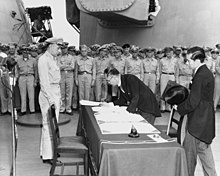End of World War II in Asia
The American occupation of Japan lasted from the end of the war until April 28, 1952, when the Treaty of San Francisco came into effect.
By the time the Suzuki cabinet took office on April 7, 1945, it became clear that the government's unannounced aim was to secure peace.
[8] The repeated attempts to establish unofficial communication with the Allies included sending Prince Fumimaro Konoe to Moscow to try to get the Soviet Union to make the Americans stop the war.
[8] On August 6, 1945, a gun-type nuclear bomb, Little Boy, was dropped on Hiroshima from a special B-29 Superfortress named Enola Gay, flown by Col. Paul Tibbets.
[9] After the bombing of Hiroshima, Harry Truman said that "We have spent two billion dollars on the greatest scientific gamble in history—and won."
[9] On August 9, 1945, a second and more powerful plutonium implosion atomic bomb, Fat Man, was dropped on Nagasaki from a different Silverplate B-29 named Bockscar, flown by Major General Charles Sweeney.
[12] On August 9, after the Nagasaki atomic bombing, shortly before midnight, Hirohito entered a meeting with his cabinet, where he said that he did not believe Japan could continue to fight the war.
1 on August 17, which ordered all Japanese forces to unconditionally surrender to an Allied power in the Pacific, depending on the location.
Sergeant Anthony Marchione, 19, a photographer's assistant, was fatally wounded in the attack and would be the last American killed in air combat in the Second World War.
[19] After Japan's defeat in 1945, most of the international community, with the exception of Britain, did not accept Thailand's declaration of war, as it had been signed under duress.
[36] In the postwar period the Thai government had close relations with the United States, which it saw as a protector from the communist revolutions in neighbouring countries.
[38] The San Francisco Peace Treaty, signed on September 8, 1951, marked the end of the Allied occupation, and after it came into force on April 28, 1952, Japan was once again an independent country.
Gen. MacArthur desired their immediate repatriation to Japan, not just for humanitarian reasons but also to lift the economic burden of the newly liberated territories.
[43][44] Emperor Hirohito and all members of the imperial family such as Prince Asaka, were not prosecuted for involvement in any the three categories of crimes.
Herbert Bix explains that "the Truman administration and General MacArthur both believed the occupation reforms would be implemented smoothly if they used Hirohito to legitimise their changes.




